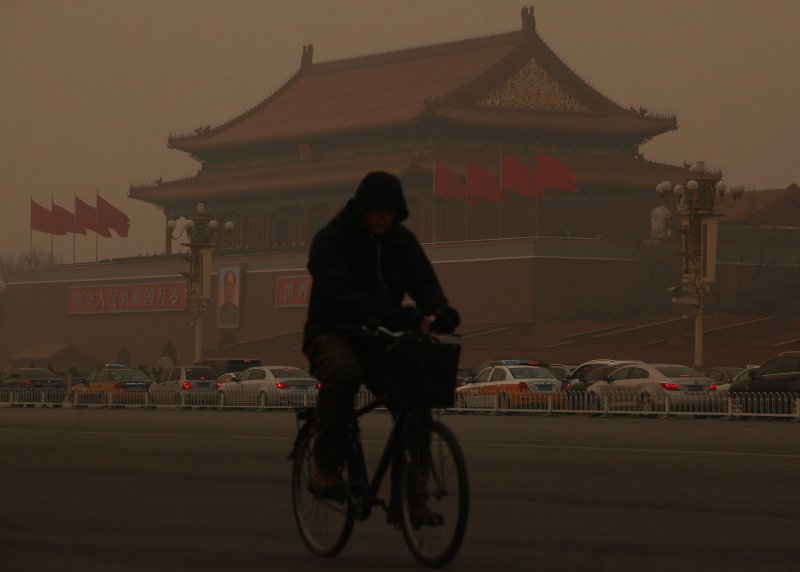A heavy smog hangs over Beijing on January 14, 2013. Public anger in China, due to dangerous levels of air pollution which blanketed China's capital in acrid smog, spread Monday as state media queried official transparency and the nation's breakneck development. UPI/Stephen Shaver |
License Photo
BEIJING, Jan. 23 (UPI) -- The city of Beijing aims to decrease concentrations of major pollutants by 2 percent this year, an official said.
Measures announced Tuesday by Beijing acting Mayor Wang Anshun in a report include getting rid of at least 180,000 older cars and trucks in the city, encouraging the use of less-polluting vehicles and shutting about 450 factories.
Wang said the government would "build a city with blue sky, green land and clean water" and "considerably cut PM2.5 in the air" referring to the measurement of air pollution particles less than 2.5 micrometers in diameter, which pose health risks.
The World Health Organization recommends that PM2.5 levels be kept below 25 micrograms per cubic meter. Earlier this month, Beijing air quality levels reached nearly 900 micrograms.
Ma Jun, director of Beijing's Institute of Public and Environmental Affairs, said it would be hard for the capital to clean its air.
The proposed 2 percent reduction of concentrations of major pollutants "will not give Beijing a blue sky," Ma told the South China Morning Post. "But it certainly shows the authorities' determination to adopt a more transparent approach to solving the pollution problem."
In his report, Wang also said that the density of major pollutants, such as sulfur dioxide and nitrogen dioxide, has dropped an average of 29 percent over the past five years.
Yet Wednesday, air quality in Beijing hit dangerous levels of PM2.5 readings of up to 400 micrograms as smog blanketed the city, prompting some deputies to recommend deleting that reference from the report to avoid disputes from the public.
Deborah Seligsohn, an expert on China's environment at the University of California, San Diego, says there is no one solution for China's air pollution, noting that underlying causes include power plants, small factories, automobile emissions, rampant construction and farmers burning coal for heat.
"The thing about PM2.5 is there are four different sources: chemical reactions from sulfur dioxide, nitrous oxides, volatile organic compounds and black carbon [soot]," Seligsohn was quoted as saying by The Guardian newspaper. "So you need to regulate a large number of sources to solve the problem."
Qu Geping, a former senior environmental administrator, blamed China's environmental problems on unchecked government power.
"I have to admit that governments have done far from enough to rein in the wild pursuit of economic growth, and failed to avoid some of the worst pollution scenarios we, as policymakers, had predicted," Qu told the South China Morning Post. "It is because the power is still above the law."















